Today marks a special day for PC gamers with the return of the $250 graphics card, and what we are seeing from Intel looks very promising. That’s right – Intel appears to be revitalizing PC gaming by delivering a GPU that outperforms both the GeForce RTX 4060 and Radeon RX 7600 while costing less and, importantly, offering more VRAM: 12GB instead of just 8GB.
This new graphics card is called the Arc B580. It is based on the new Xe2 architecture and is designed for 1440p gaming. Key features of the Xe2 architecture include the 2nd-gen Xe core with SIMD16 execution, which provides significant efficiency improvements; a new and enhanced ray tracing hardware unit with double the throughput, and 2nd-gen XMX engines.
In terms of specifications, the B580 is manufactured using TSMC’s N5 process, packing 19.6 billion transistors into a 272mm² die. It includes 20 Xe cores, 160 Xe Vector Engines, 160 XMX Matrix Engines, 20 RT units, 160 TMUs, and 80 ROPs.
Intel Arc Specs
| Intel Arc B570 | Intel Arc B580 | Intel Arc A580 | Intel Arc A770 | ||
|---|---|---|---|---|---|
| Price (MSRP) | $220 | $250 | $180 | $330/$350 | |
| Release Date | Jan 16, 2025 | Dec 12, 2024 | Oct 10, 2023 | Oct 14, 2023 | |
| Process | TSMC N5 | TSMC N6 | |||
| Transistors (billion) | 19.6 | 21.7 | |||
| Die Size (mm2) | 272 mm2 | 406 mm2 | |||
| Core Config | 18 Xe2 | 20 Xe2 | 24 Xe | 32 Xe | |
| GPU Boost Clock | 2750 MHz | 2850 MHz | 1700 MHz | 2400 MHz | |
| Memory Capacity | 10 GB | 12 GB | 8 GB | 8 / 16 GB | |
| Memory Speed | 19 Gbps | 16 Gbps | 16 / 17.5 Gbps | ||
| Memory Type | GDDR6 | ||||
| Bus Type / Bandwidth | 160-bit | 192-bit | 256-bit | ||
| Total Board Power | 150W | 190W | 175W | 225W | |
The cores are clocked at 2,670 MHz but can boost up to 2,850 MHz. The memory system features 12GB of GDDR6 memory running at 19 Gbps, and with a 192-bit wide memory bus, it delivers 456 GB/s of memory bandwidth. The board power rating is set at 190 watts, and it uses a PCIe 4.0 x8 interface.

On hands for testing, we have the Intel Arc B580 Limited Edition, along with a few AIB models. However, the AIB models are under embargo for another 24 hours. The Limited Edition model features Intel’s signature stealth black design in a dual-fan configuration. The PCB is compact, allowing the second fan to provide additional airflow through the card.

Test System
Our testing setup has been updated for GPU benchmarks, and that’s a new system featuring the Ryzen 7 9800X3D. All performance data presented in this review is fresh and up to date, collected over the past week.
| CPU | AMD Ryzen 7 9800X3D | ||
| Motherboard | Gigabyte X670E Master (BIOS F33f – ReBAR enabled) |
||
| Memory | G.Skill Trident Z5 RGB DDR5-6000 CL30 [CL30-38-38-96] |
||
| Graphics Card |
|
||
| ATX Case | MSI Prospect 700R | ||
| Power Supply | Kolink Regulator Gold ATX 3.0 1200W | ||
| Storage | TeamGroup T-Force A440 M.2 PCIe Gen4 NVMe SSD 4TB |
||
| Operating System | Windows 11 24H2 | ||
| Display Driver | Nvidia GeForce Game Ready 566.36 AMD Radeon Adrenalin 24.12.1 Intel Arc 32.0.101.6319 |
There’s a wealth of data to explore, so let’s dive in.
Benchmarks
Star Wars Jedi: Survivor
Let’s start with Star Wars Jedi: Survivor at 1080p, the new Arc B580 performs well, outperforming the RTX 4060 by a 7% margin and the RX 7600 by a 10% margin. However, it is 5% slower than the 6700 XT and 7% slower than the 3060 Ti.

If we increase the resolution to 1440p, the B580 still delivers 51 fps using maximum in-game quality settings without upscaling. This matches the performance of the 6700 XT, making it 16% faster than the 4060 and 19% faster than the 7600 – an impressive result.
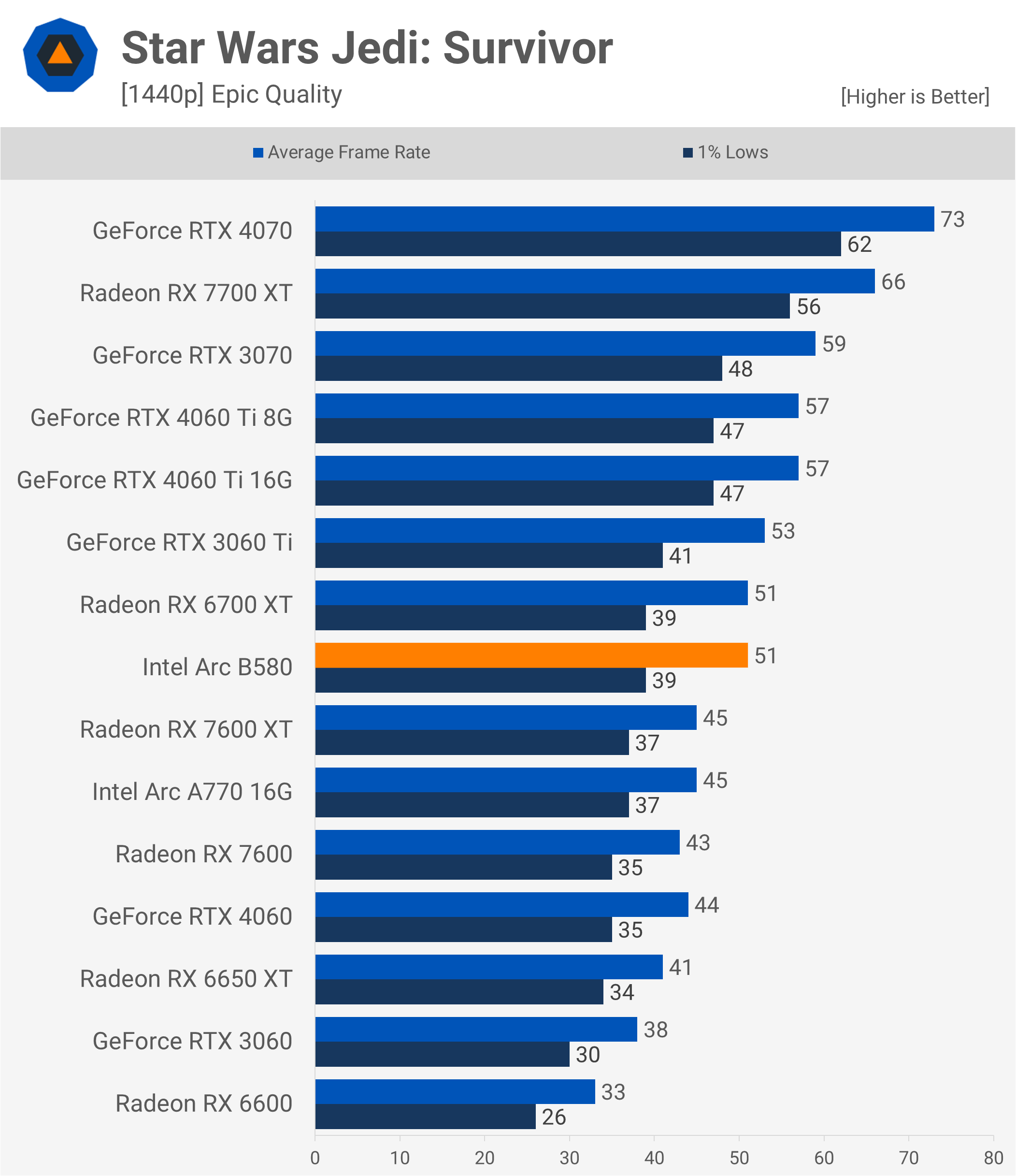
A Plague Tale: Requiem
Next, we have A Plague Tale: Requiem, where the B580 excels, achieving 77 fps at 1080p. This translates to an 18% advantage over the 7600 and a 20% lead over the 4060, coming close to the performance of the 4060 Ti.

The 1440p results are much the same. The B580 is 21% faster than the 7600 and 24% faster than the 4060. Although the average frame rate of 56 fps at this resolution isn’t amazing, it is achieved using the highest quality preset. Upscaling can be enabled to push frame rates beyond 60 fps.

Cyberpunk 2077: Phantom Liberty
For Cyberpunk 2077: Phantom Liberty, we tested the “high preset” with upscaling disabled, rendering at a native 1080p resolution. Under these conditions, the B580 achieves 90 fps, providing an 11% improvement over the 7600 and a 15% boost over the 4060. It performs on par with the 6700 XT and 3060 Ti.
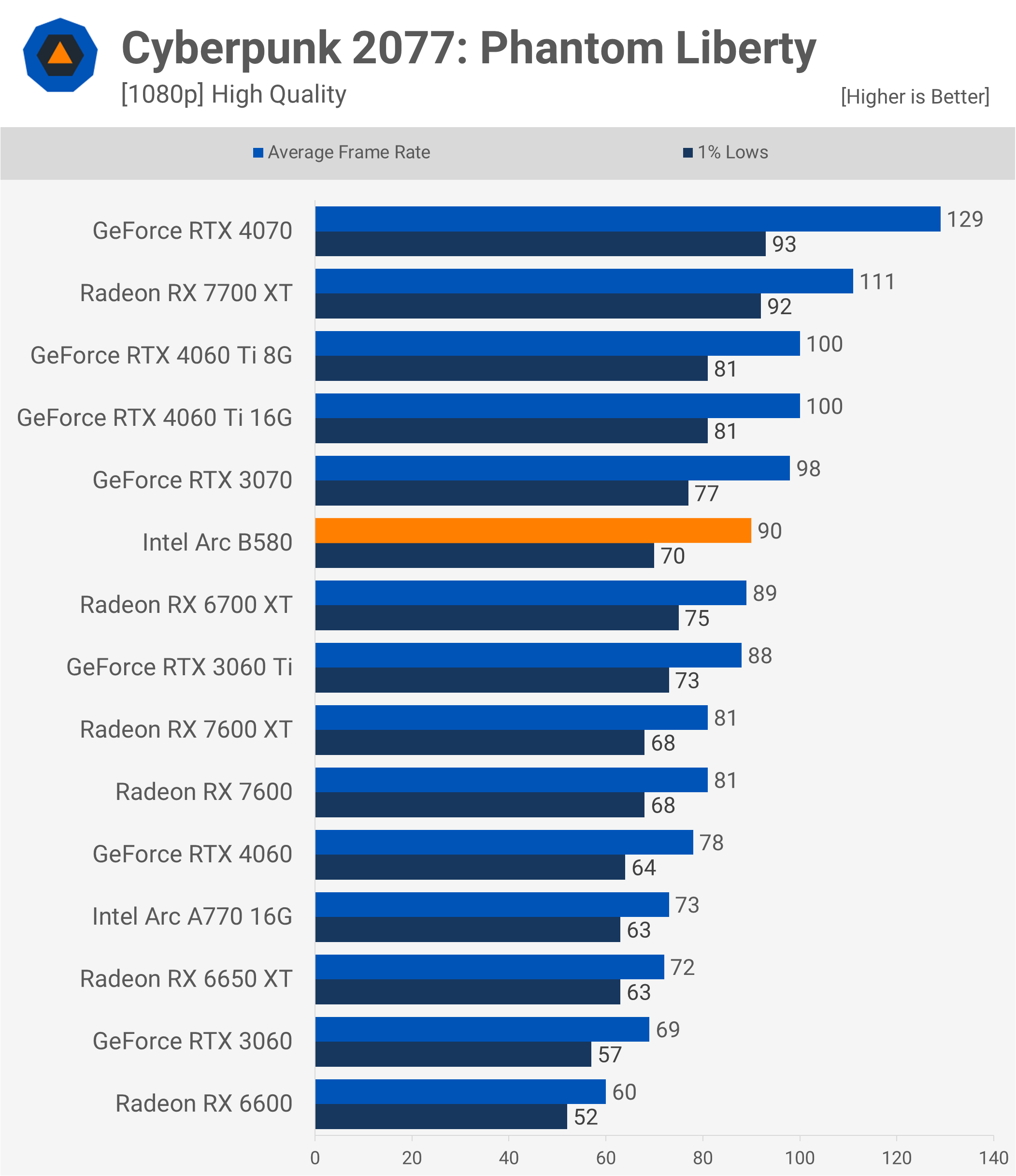
At 1440p, the B580 performs even better relative to competing GPUs, coming close to the 4060 Ti with an average of 63 fps. This puts it 19% ahead of the 7600 and a significant 29% faster than the 4060. It’s worth noting that we tested in-game performance rather than using the built-in benchmark for Cyberpunk 2077.
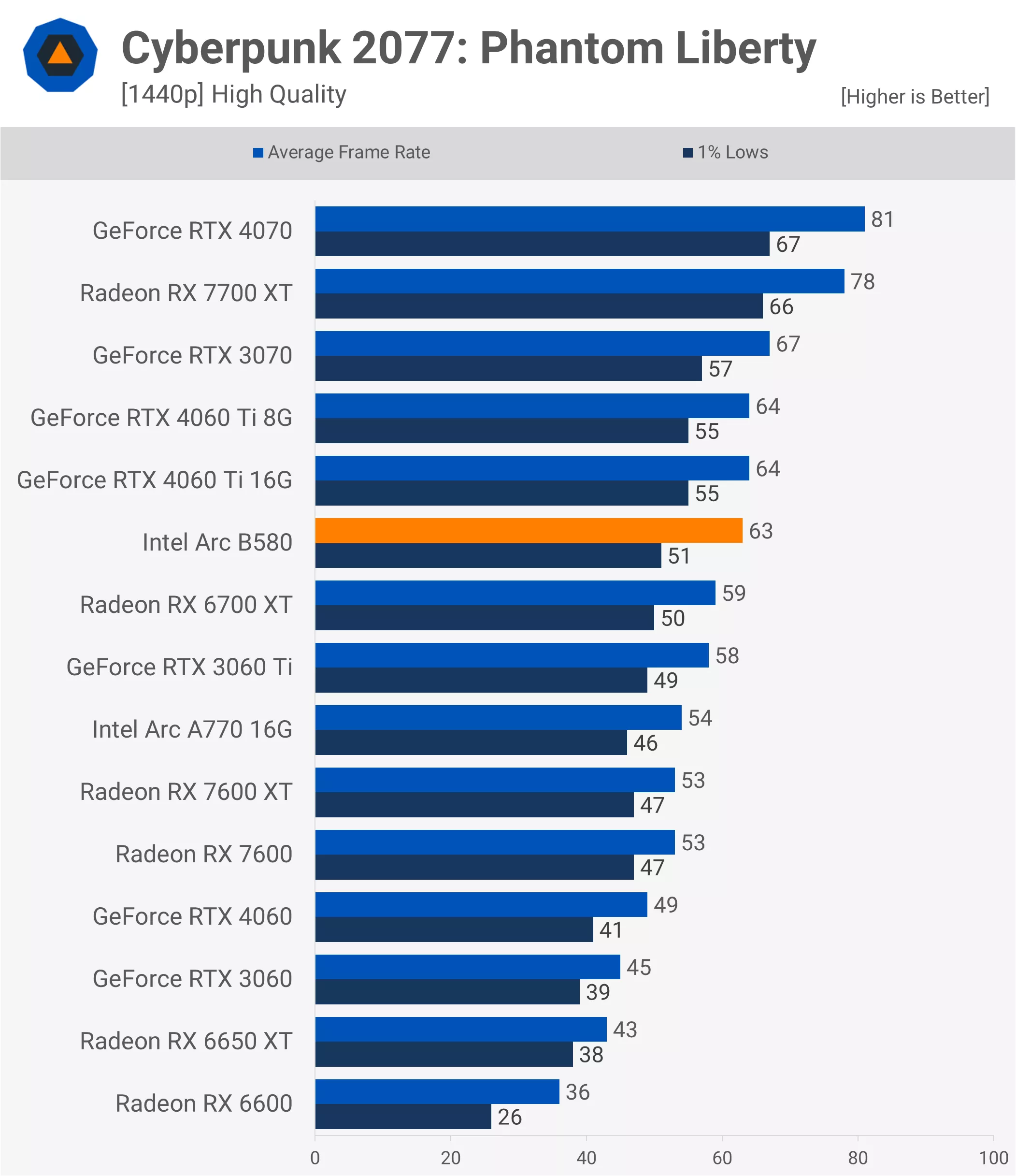
Dying Light 2 Stay Human
The B580 also shines in Dying Light 2, where it delivers 74 fps at 1080p, matching the performance of the 4060 Ti. This places it 17% ahead of the 4060 and 21% ahead of the 7600.

Remarkably, at 1440p, the B580 slightly edges out the 4060 Ti, albeit by a single frame, resulting in similar overall performance. For a $250 graphics card, this is impressive. At this resolution, the B580 outpaces the 4060 by 25% and the 7600 by 34%, yielding excellent results.
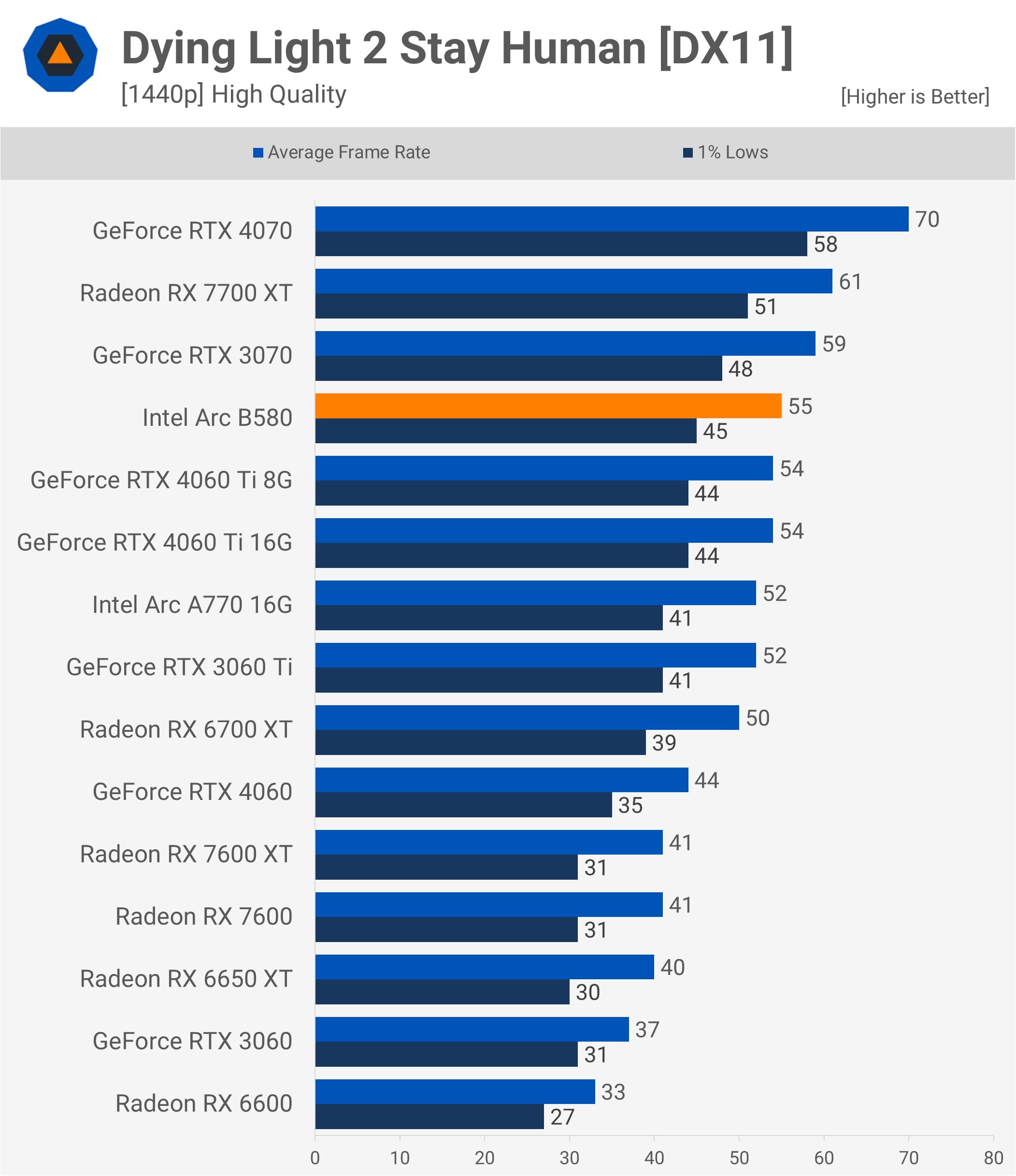
Dragon Age: The Veilguard
The Arc B580 stumbled a bit in Dragon Age: The Veilguard, where it matches the 6700 XT – a typically strong result – but falls 15% short of the 4060, achieving an average of 52 fps at 1080p. Overall performance in this title is underwhelming but consistent with what is seen from comparable Radeon GPUs.
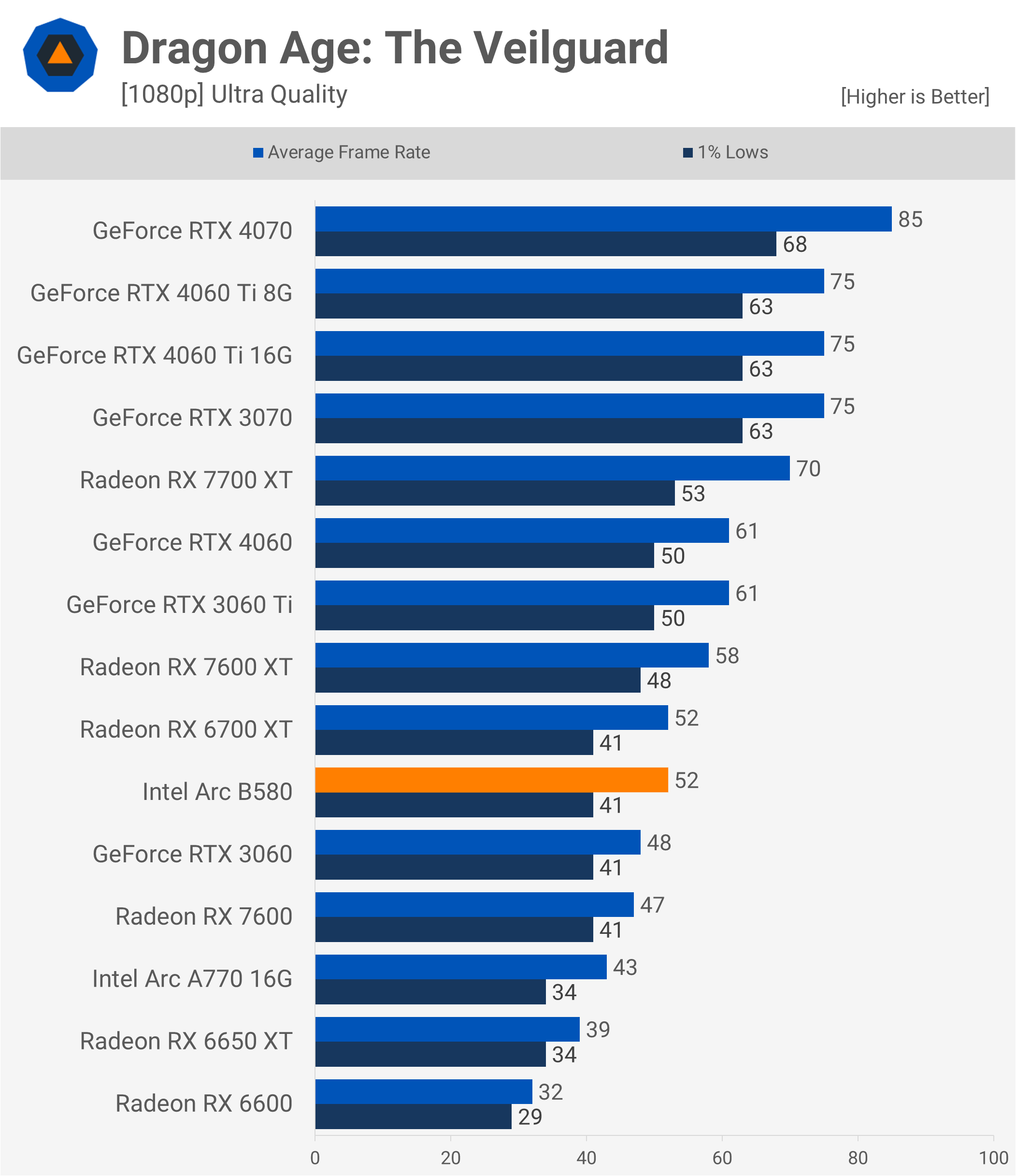
Interestingly, the B580 scales differently across resolutions compared to Radeon and GeForce GPUs. Increasing the resolution to 1440p results in only a 17% performance drop for the B580, while the RTX 4060 experiences a 37% decline. As a result, the B580 edges ahead of the 4060 at this resolution.

This discrepancy can largely be attributed to VRAM, although other factors are at play. At 1440p, the RX 7600 struggles with its limited VRAM, leading to poor performance. While 8GB GeForce GPUs fare better, even the 8GB 4060 Ti is up to 11% slower than its 16GB counterpart. Extended gameplay beyond the benchmark period could exacerbate these issues for 8GB GeForce GPUs.
The B580’s 12GB of VRAM provides an advantage, enabling it to deliver better average frame rates and more consistent frame times.
War Thunder
Next, we have War Thunder, where the B580 performs well, though it is only 5% faster than the 7600 and 7% faster than the 4060. On the other hand, it matches the 7700 XT and 3060 Ti in performance.
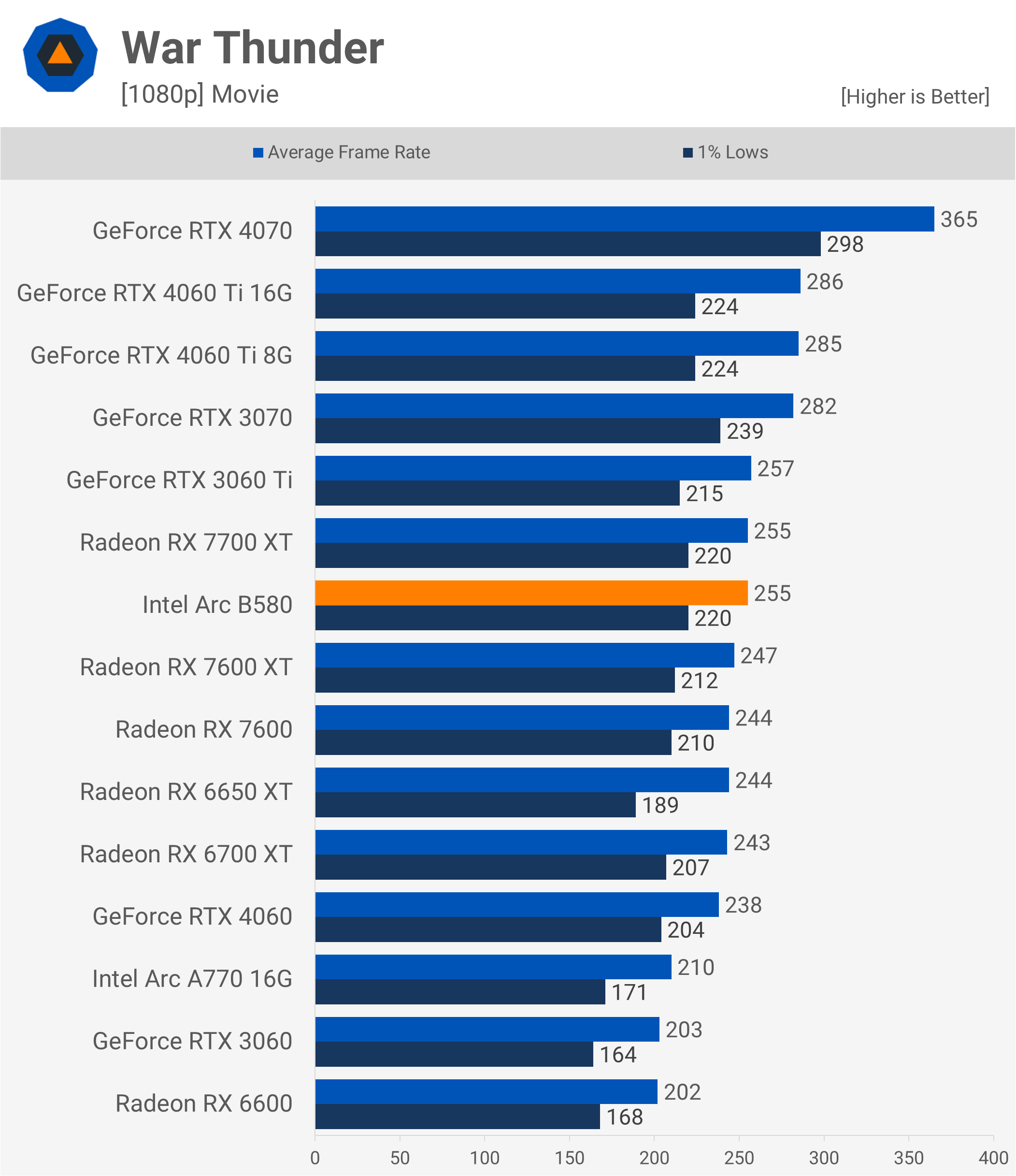
At 1440p, the B580 shows more separation, coming in 11% faster than the 7600 and 16% faster than the 4060. Overall, this is solid performance from Intel’s latest Arc GPU.
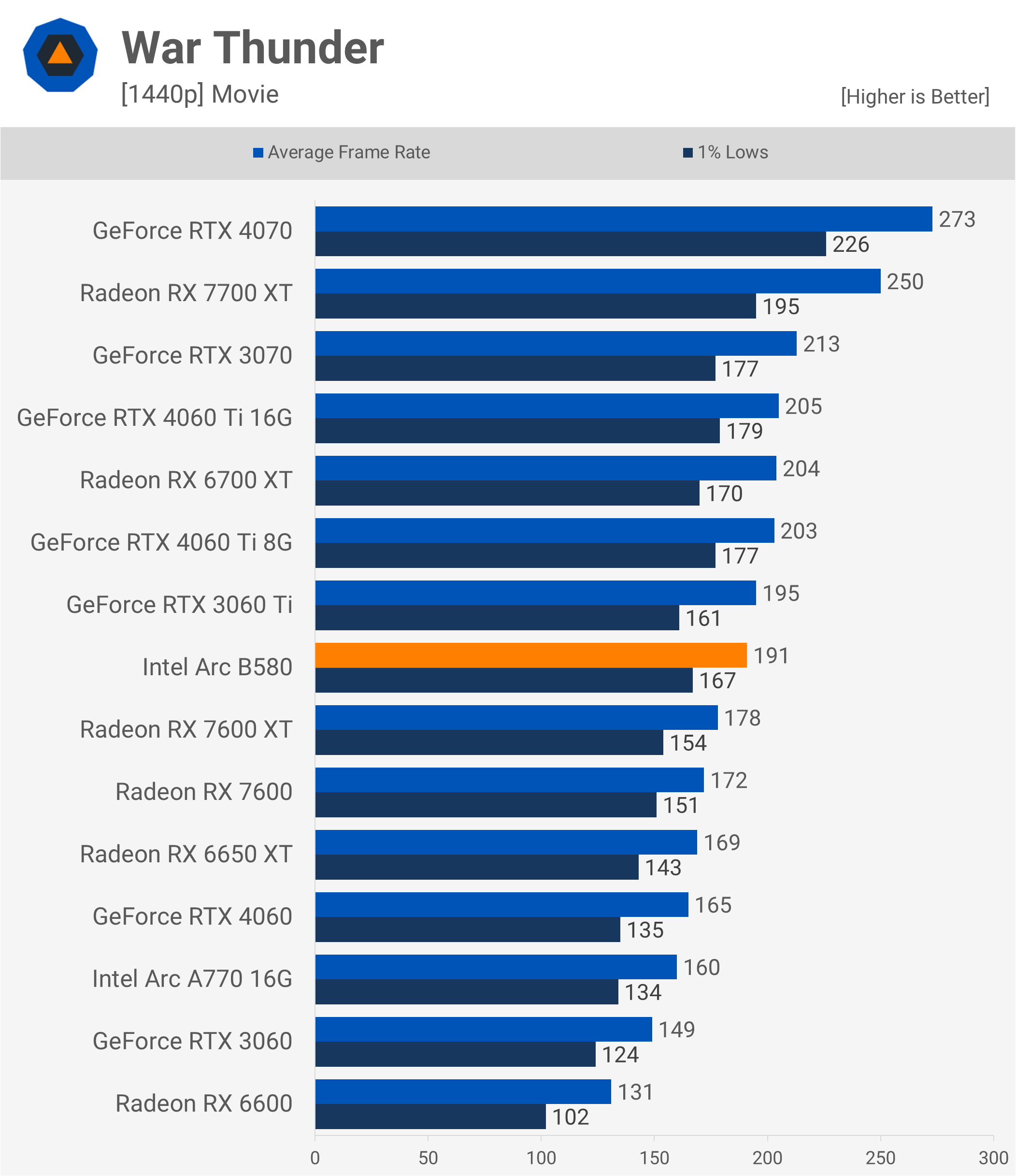
Marvel’s Spider-Man Remastered
Next is Spider-Man Remastered. We triple-checked the data here because the B580 delivered exceptional results, rendering 152 fps on average at 1080p in our test. This matches the performance of the 4060 Ti and makes it nearly 70% faster than the 4060 and almost 50% faster than the 7600.

Interestingly, the performance gap narrows at 1440p, a trend we haven’t seen before. Even so, the B580 remains 43% faster than the 4060 and 47% faster than the 7600. Overall, these are outstanding results.

Hogwarts Legacy
The B580 is less impressive in Hogwarts Legacy, delivering 71 fps at 1080p. This matches the performance of the 4060 but is 7% slower than the RX 7600. Still, performance is acceptable overall using the high-quality preset.
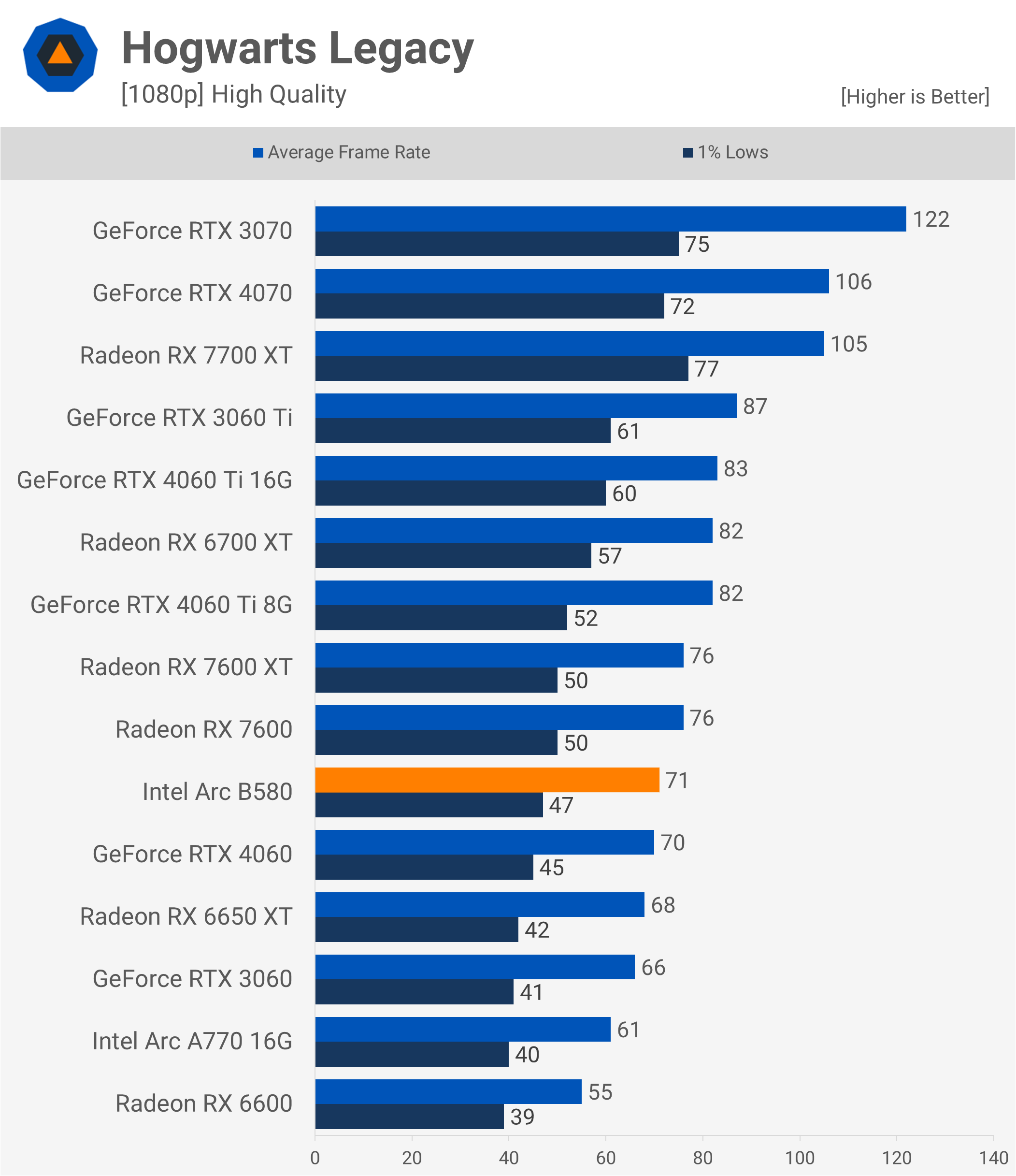
At 1440p, the B580 scales better, matching the 7600 and coming in 11% faster than the 4060.

Warhammer 40,000: Space Marine 2
Unfortunately, the B580’s performance in Warhammer 40,000: Space Marine 2 at 1080p is underwhelming. Although 62 fps is playable, it is 16% slower than the 4060 and 18% slower than the 7600, which is disappointing.
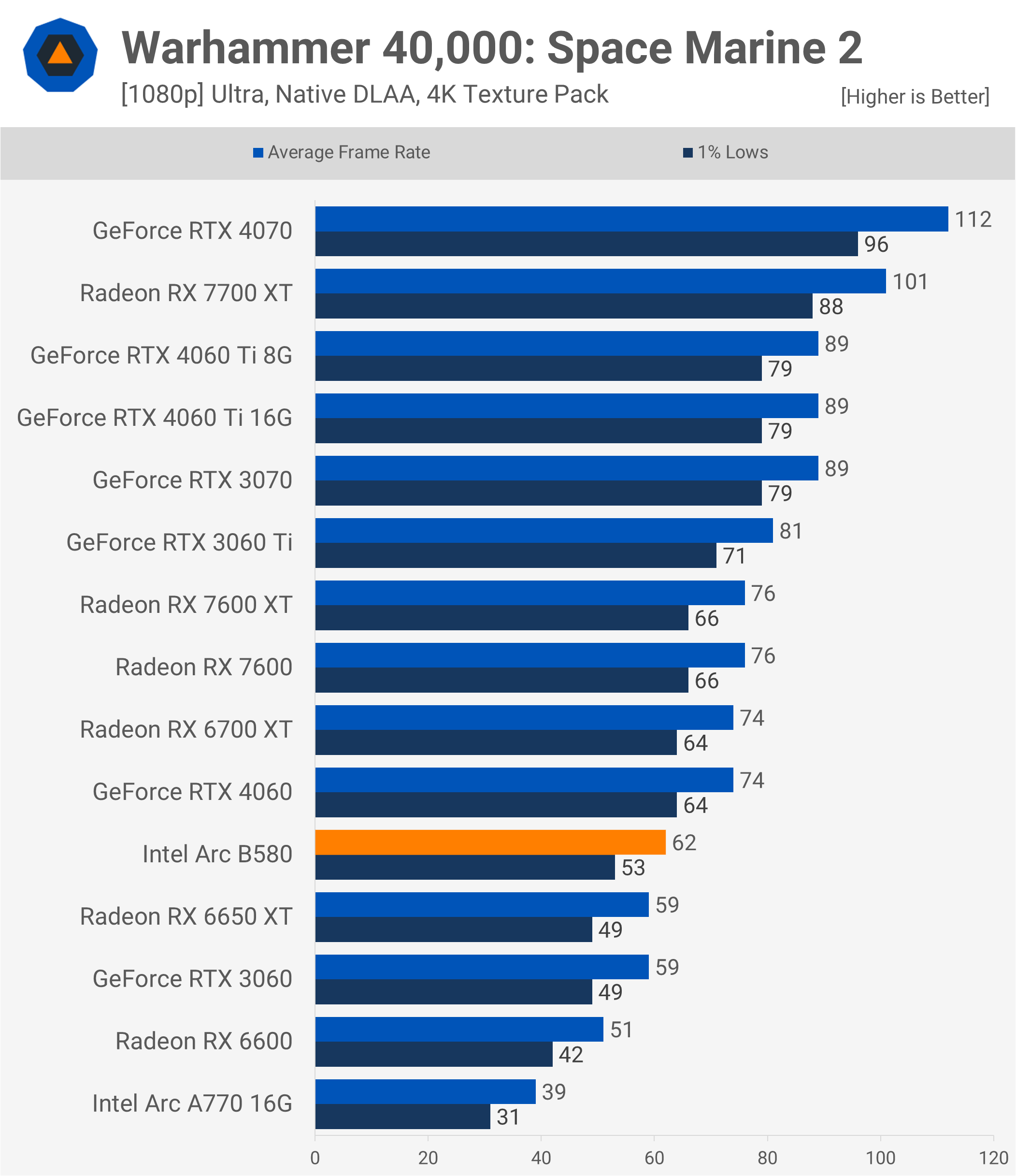
At 1440p, the B580 experiences only a small performance drop and manages to slightly edge out the RTX 4060. While the performance is not stellar, it is reasonable given the price.

The Last of Us Part I
In The Last of Us Part I, the B580 performs well at 1080p, averaging 75 fps. This makes it 10% faster than the 4060 and 14% faster than the 7600.

At 1440p, using the ultra preset in the test section, performance issues arise due to the limited VRAM of 8GB GPUs. Although the average frame rate for the B580 looks good, severe frame stuttering drags down the 1% lows significantly. Compared to the 4060, the B580 is 29% faster in terms of average frame rates and 110% faster in 1% lows. With an average of 54 fps, the B580 provides a playable experience.

Star Wars Outlaws
Next is Star Wars Outlaws. The initial review driver caused stability issues in this title, but Intel released a new driver before testing, resolving these problems. Once stable, the B580 delivered solid results, being 18% faster than both the 4060 and 7600. However, at 1080p, the card only achieved 40 fps, meaning players will need to lower the quality settings or enable upscaling.
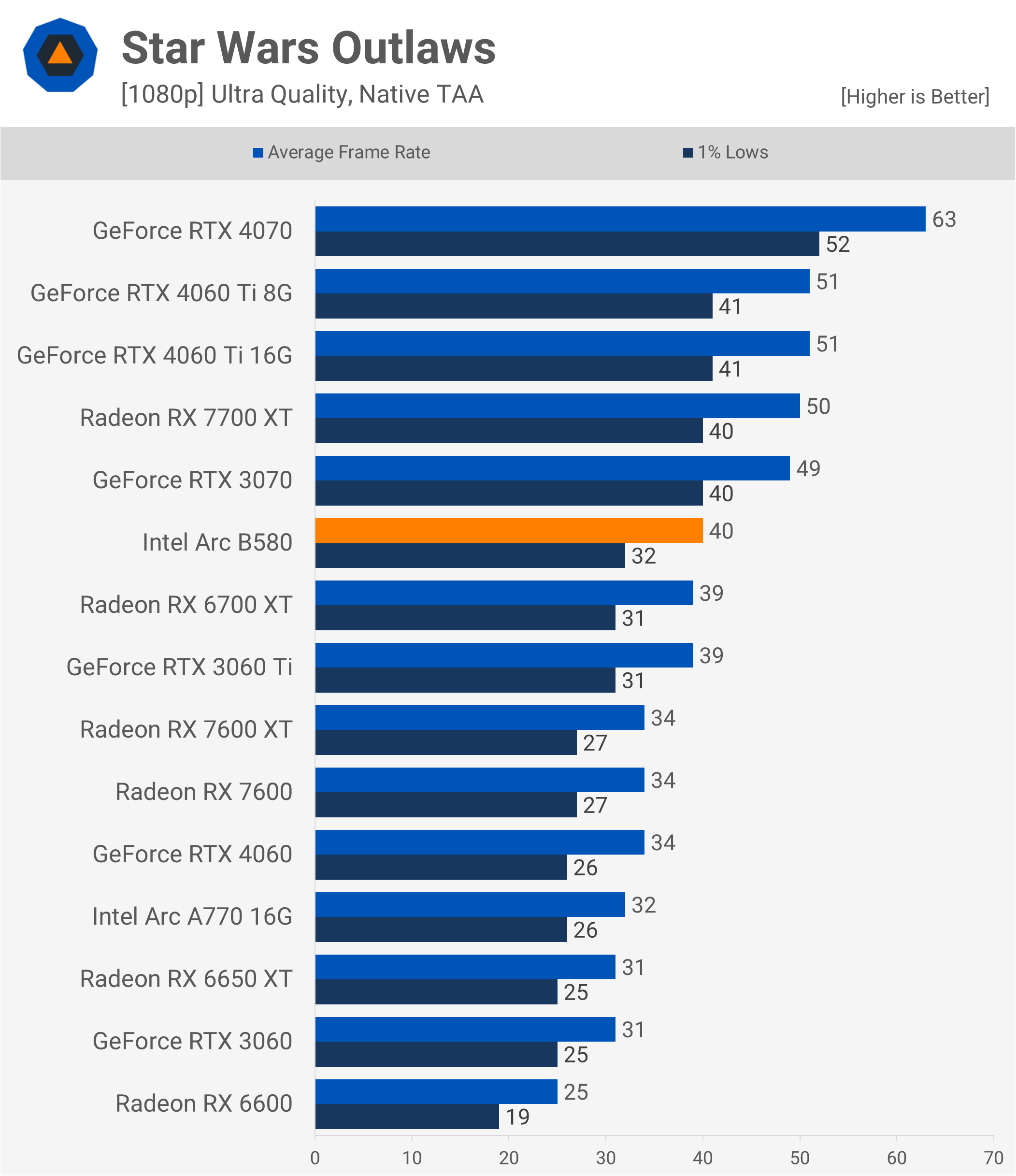
At 1440p, performance is insufficient for smooth gameplay unless quality settings are significantly reduced. This limitation applies to most graphics cards tested here.

Starfield
Lastly, we tested Starfield, where the B580 struggled. In the test section, the card was 20% slower than the RTX 4060 in average frame rates, and frame time performance was poor – similar to issues observed previously with the A770.

Given the results at 1080p, 1440p is not feasible, not only due to weak frame time performance but also because the card achieves just 30 fps on average. This does not provide a great gaming experience.
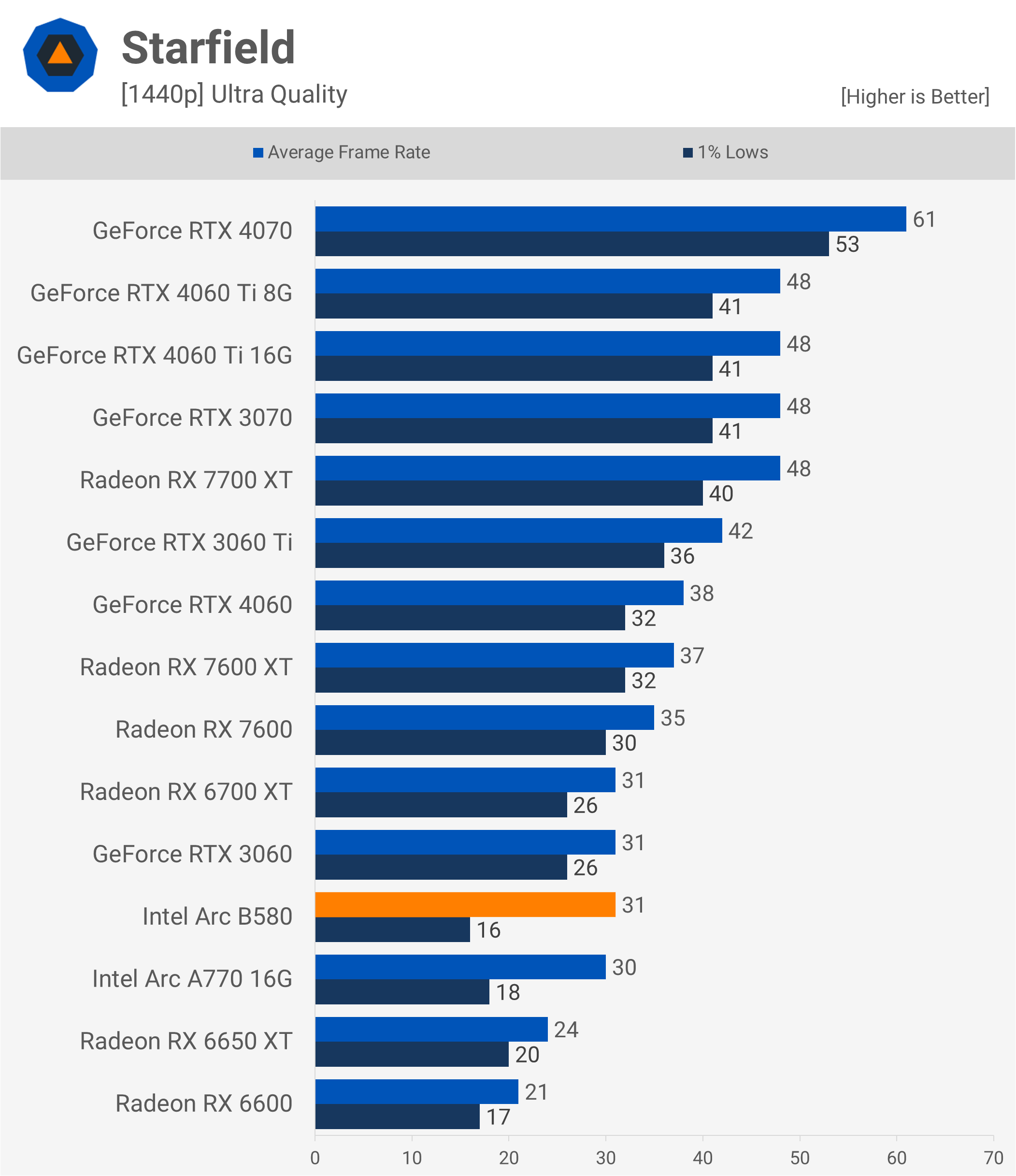
12 Game Average
Average 1080p
Here is a look at the 12-game average performance at 1080p. As shown, the B580 performs well, delivering 7% greater performance on average than the RTX 4060 and 8% more than the RX 7600. While these are respectable margins, they are not groundbreaking. It’s also important to note that the 7600 and 4060 have been on the market for over a year and a half and are expected to be replaced within the next six months. While the B580 looks promising at $250, it is competing against older products.

Average 1440p
At 1440p, the B580 performs significantly better relative to the 7600 and 4060, delivering 14% greater performance than the 4060 and 21% more than the 7600. This places it alongside the RTX 3060 Ti and slightly ahead of the 6700 XT, which represents strong performance for its price point.

Power Consumption
Star Wars Outlaws
In terms of power consumption, the B580 is neither outstanding nor particularly bad. For instance, in Star Wars Outlaws, it consumed 22% more power than the 4060, which amounts to an additional 49 watts. While the B580 was 8% faster in this test, the GeForce GPU remains the more power-efficient option.

Starfield
In Starfield, the B580 consumed about 16% more power than the 4060, using roughly the same amount of power as the RX 7600. However, the 4060 was 23% faster in this title, making Starfield a poor showing for the B580 in terms of efficiency.
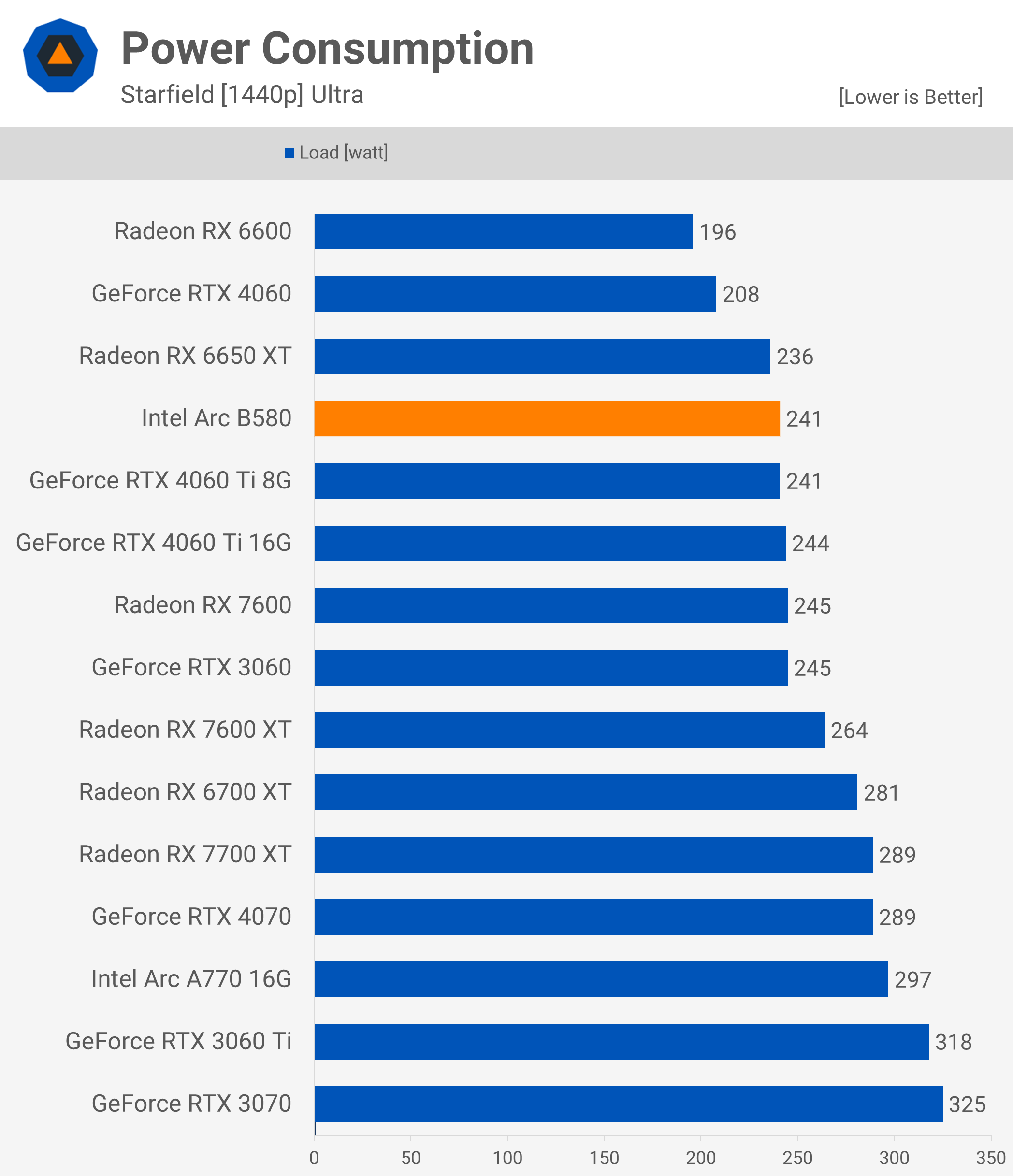
Space Marine 2
Finally, in Space Marine 2, the B580 consumed 27% more power than the 4060, translating to an additional 56 watts. Despite the higher power draw, the B580 was only 6% faster in this title.
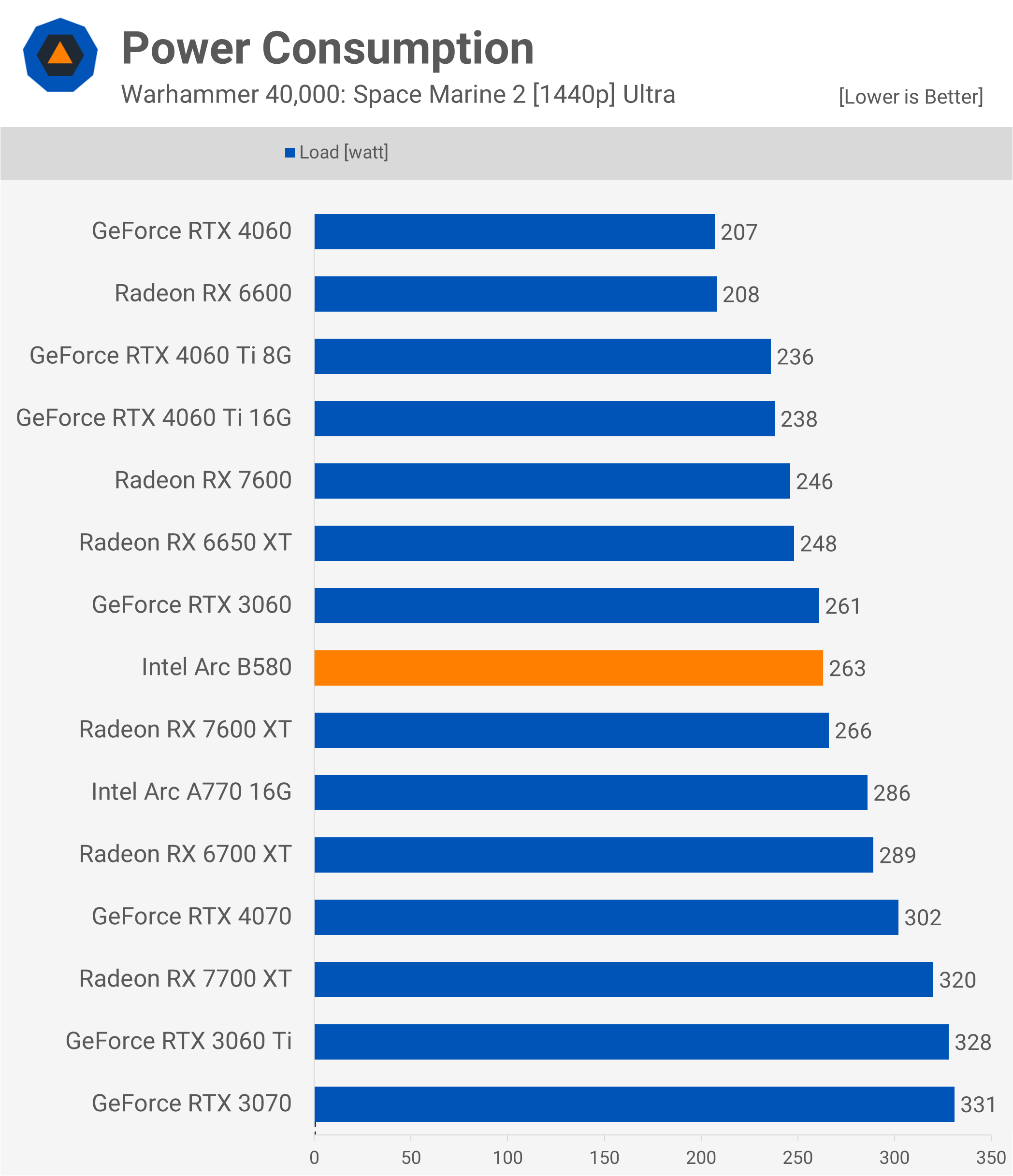
Cooling Performance
Before moving on, let’s quickly examine how the Intel Arc B580 Limited Edition graphics card performs under load. Testing was conducted inside an enclosed ATX case with a room temperature of 21°C.
Under these conditions, the B580’s GPU peaked at just 62°C, with a maximum memory temperature of 70°C. The cores operated at 2,850 MHz, and the fan speed typically ranged between 1,250 and 1,350 RPM. Overall, the card ran very cool and quiet under load.
Ray Tracing Performance
For testing ray tracing performance we have six games, all of which have been carefully selected. We spent months testing the effectiveness of RT effects in a broad range of titles and found games such as Metro Exodus Enhanced, Alan Wake II, Cyberpunk 2077: Phantom Liberty, Marvel’s Spider-Man Remastered, Black Myth: Wukong and Dying Light 2 Stay Human were among the best to showcase the technology, offering what we called “better overall” to “transformative visuals.”
For these tests, we used quality upscaling at 1080p and 1440p. This means DLSS for Nvidia GPUs that support it, FSR for Radeon GPUs and GeForce GPUs without DLSS, and XeSS for Arc GPUs. Let’s see how the B580 performs.

Metro Exodus Enhanced is a very pro-Nvidia title, yet it remains a great showcase for ray tracing. The RTX 4060 achieved 122 fps, while the RX 7600 managed only 68 fps. The B580, though slower than the 4060, delivered a smooth and playable 86 fps.

At 1440p, the B580 still managed 60 fps. While this may be acceptable to some, it is an impressive result for a $250 graphics card, especially since it was 53% faster than the 7600, though it lagged 31% behind the 4060.
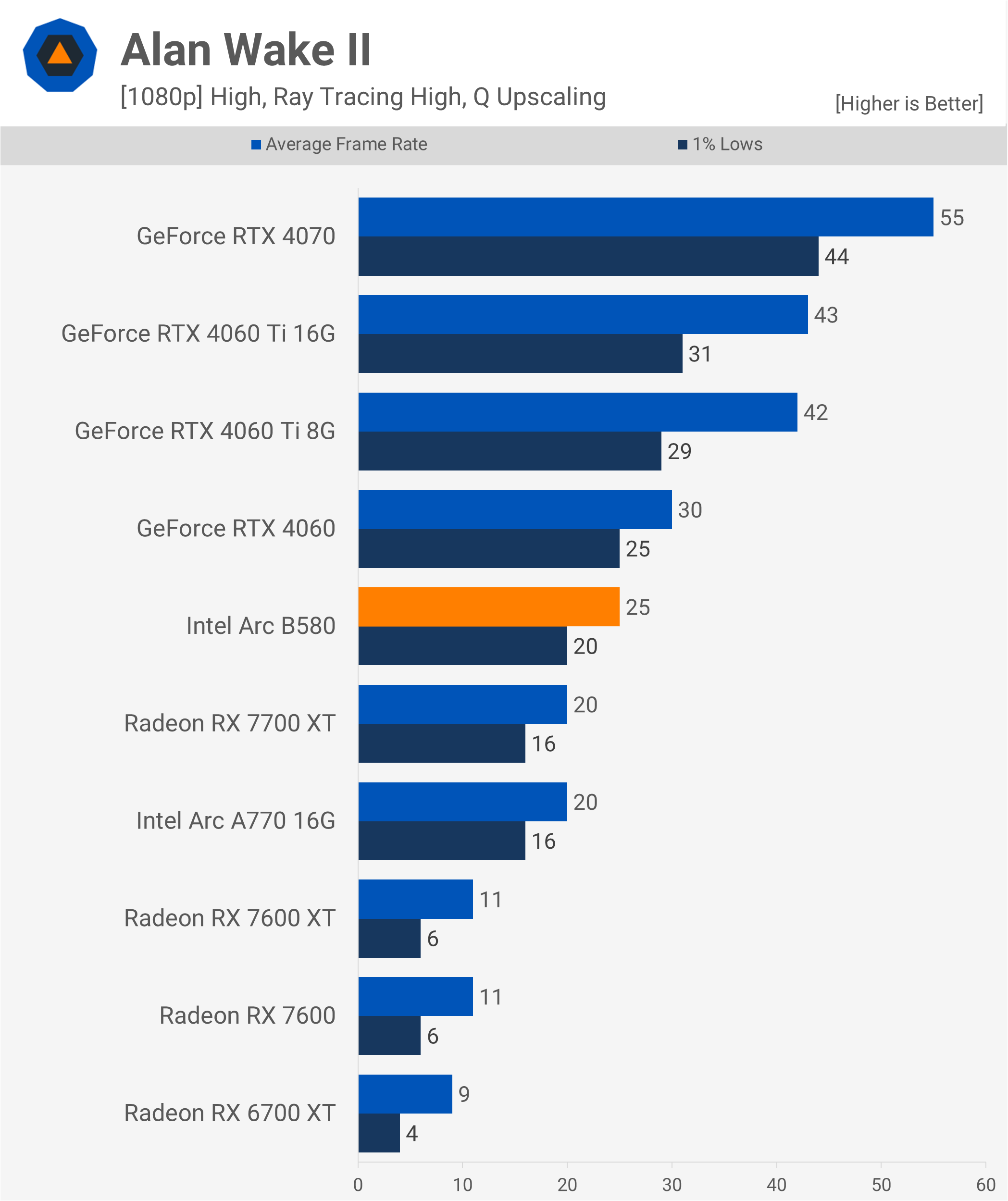
In Alan Wake II, we expected the B580 to perform poorly, similar to the RX 7600, but it managed respectable results relative to the RTX 4060. With the transformative settings enabled, neither the B580 nor the 4060 exceeded 30 fps, even with quality DLSS enabled on the 4060. This makes Alan Wake II unplayable on GPUs costing less than $600.

At 1440p, performance drops further, making this resolution entirely impractical for these GPUs, even for the RTX 4070.
For Cyberpunk 2077, we tested using the Ultra Ray Tracing quality setting, which offers significantly better visuals compared to lower settings. The Overdrive mode is transformative, but it’s unplayable on RTX 4060-class GPUs, so Ultra was the logical choice.
At 1080p, the B580 outperformed the RTX 4060, delivering 58 fps on average – a 14% improvement. While near 60 fps, relying on upscaling at 1080p is not ideal.
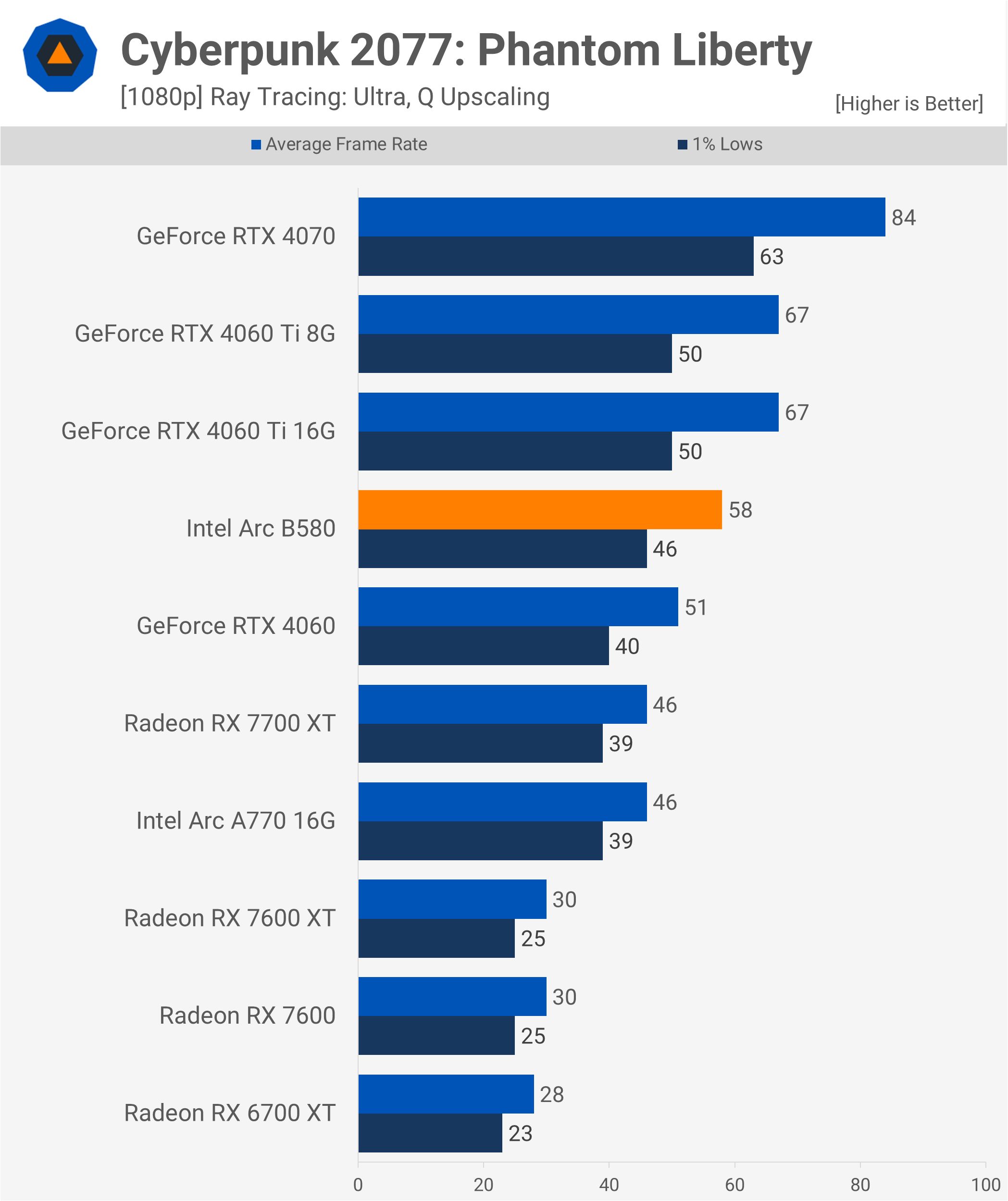
At 1440p, performance was a struggle, but relative to the 4060, the B580 stood out, achieving 41 fps – nearly 60% faster than the 4060.

For Marvel’s Spider-Man Remastered, we maxed out all visual settings, including ray tracing. The B580, however, delivered disappointing results, rendering just 67 fps at 1080p – 20% slower than the RTX 4060.

At 1440p, the B580’s performance barely changed, reducing the gap to 12% slower than the 4060. These unusual results have been confirmed by Intel, though they have yet to explain this odd scaling behavior with Arc GPUs.
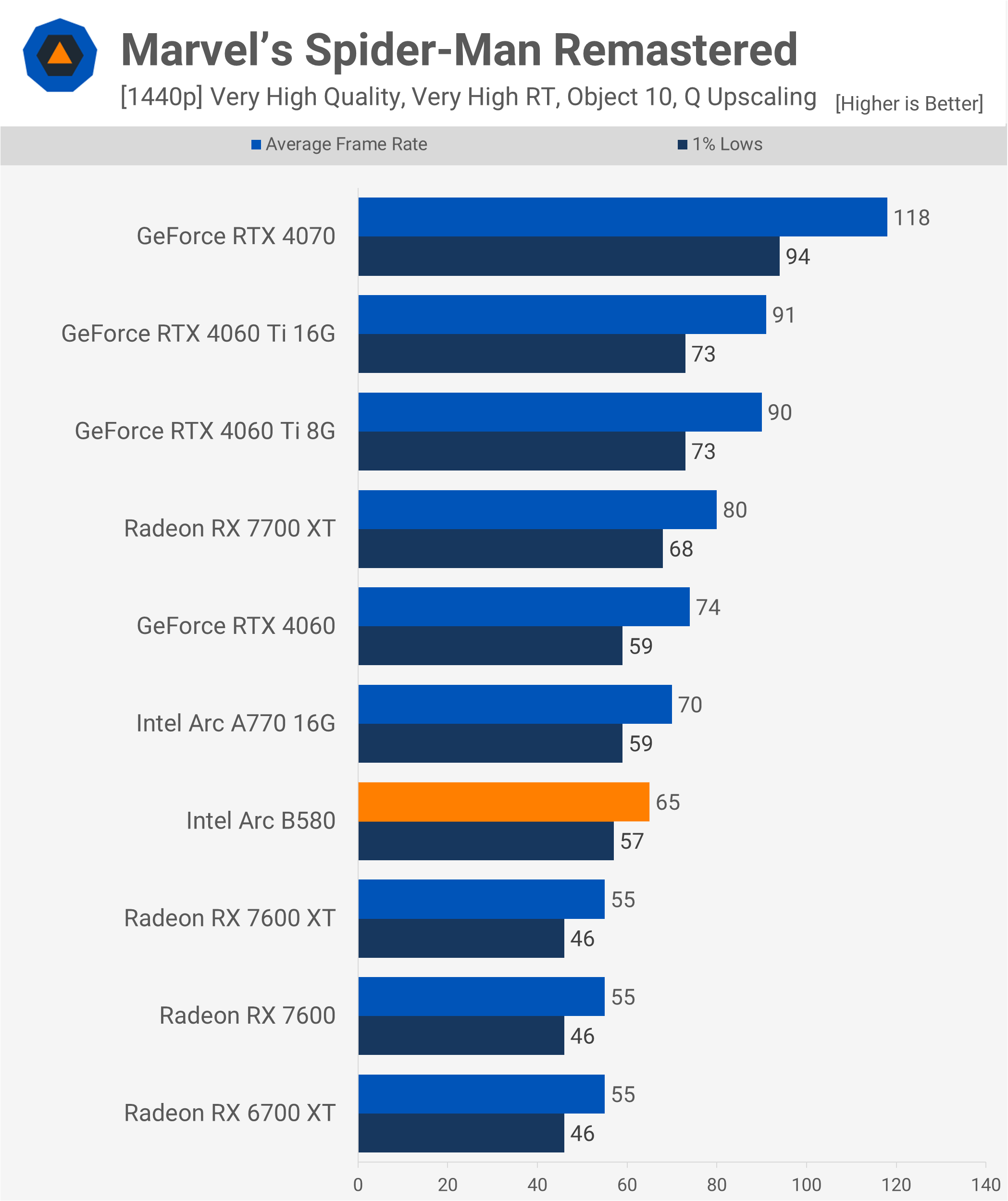
Testing Black Myth: Wukong initially posed challenges due to instability with the B580’s review driver. However, a driver update resolved the issue. With very high-quality ray tracing enabled, none of the sub-$400 GPUs delivered acceptable performance. The RTX 4060 was 84% faster than the B580, but this is irrelevant given that both GPUs failed to provide playable frame rates.
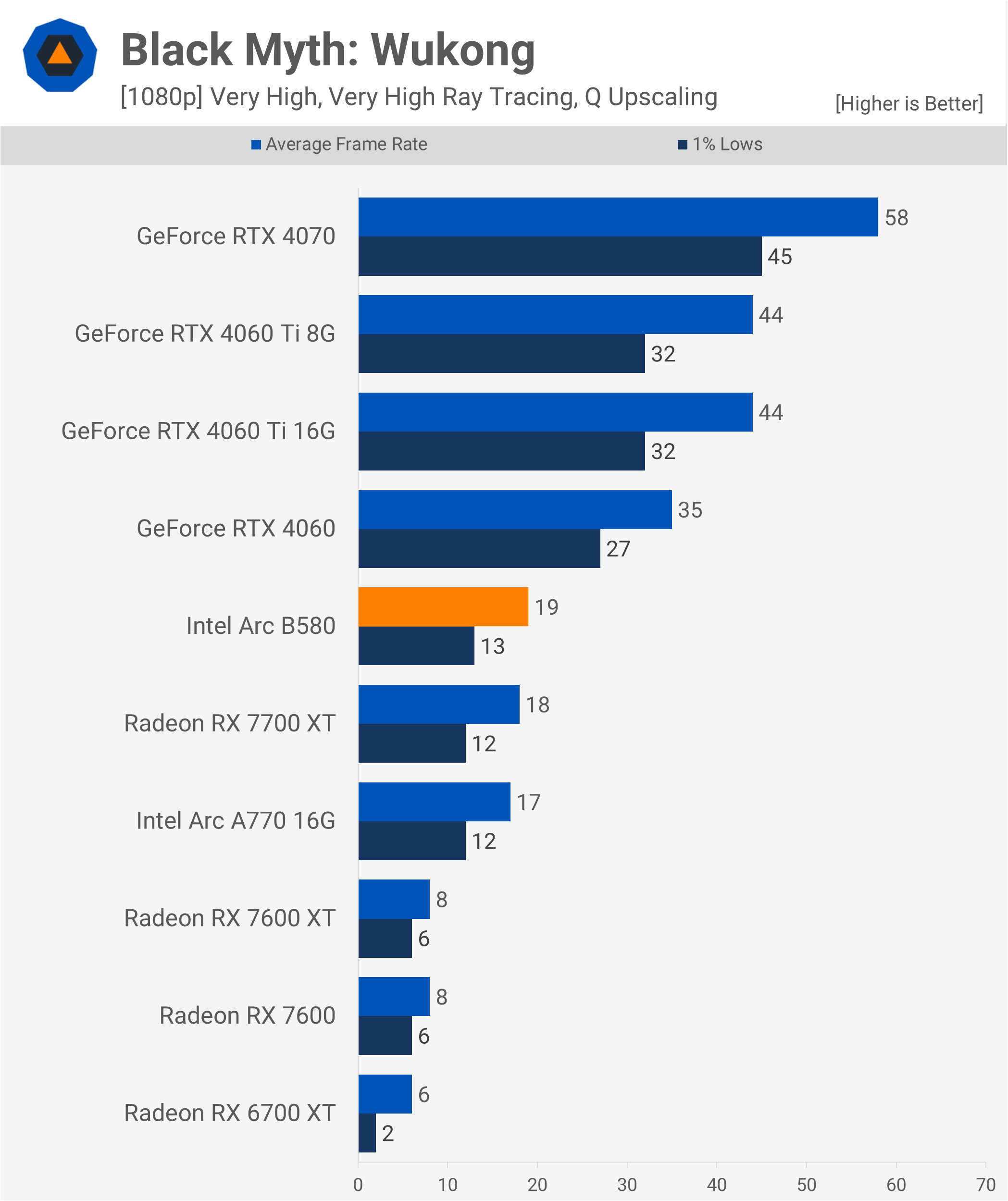
At 1440p, the performance remains unacceptable, but the data is included for reference.

In Dying Light 2, using the high ray tracing preset, the B580 averaged 62 fps at 1080p, making it 11% faster than the 4060 and 41% faster than the RX 7600. This is a strong result for Intel.
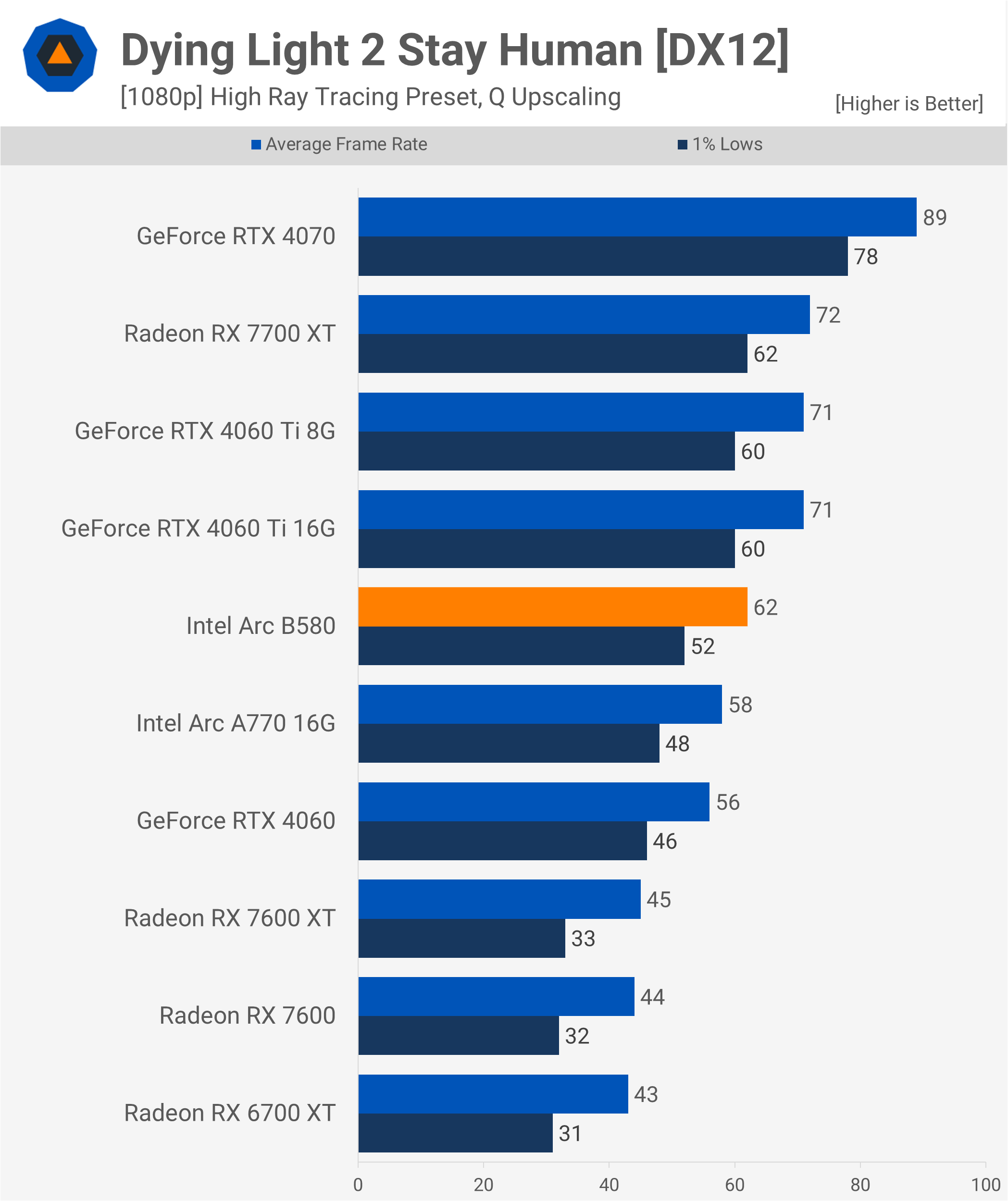
At 1440p, the B580 delivered 45 fps. While not ideal, particularly with upscaling already enabled, it was still 18% faster than the 4060 and 67% faster than the RX 7600.
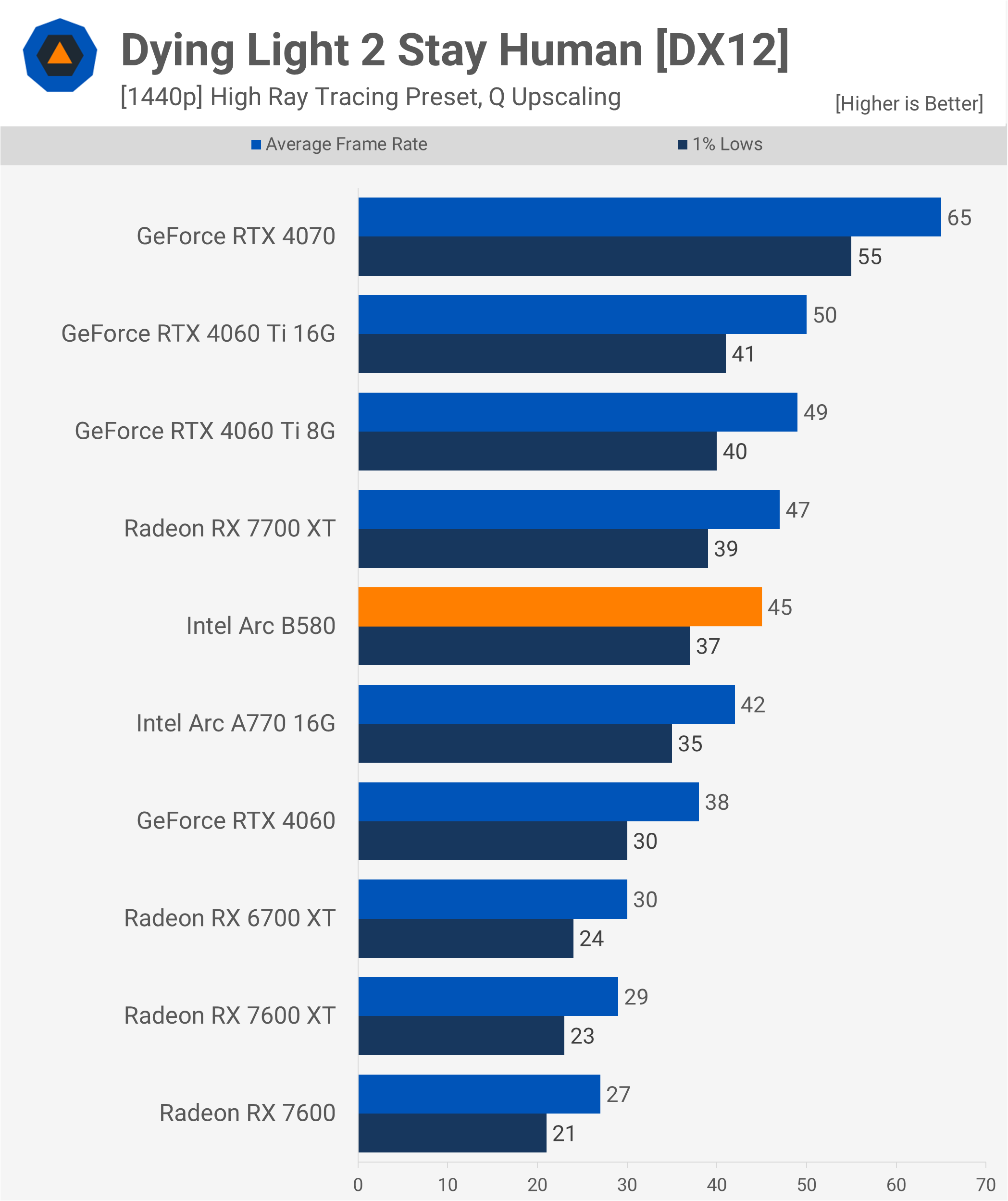
Ray Tracing Performance Summary
Looking at the ray tracing average at 1080p for these six titles, the Arc B580 was 20% slower than the RTX 4060, but 55% faster than the RX 7600. However, some results need to be taken with caution. For instance, in titles like Alan Wake II and Black Myth: Wukong, the RTX 4060 was effectively unusable, even at 1080p.

At 1440p, the B580 was 18% slower than the RTX 4060. However, in games such as Alan Wake II, Cyberpunk 2077, Dying Light 2, and Black Myth: Wukong, the RTX 4060 struggled to maintain playable frame rates even with quality DLSS enabled, resulting in a subpar experience.
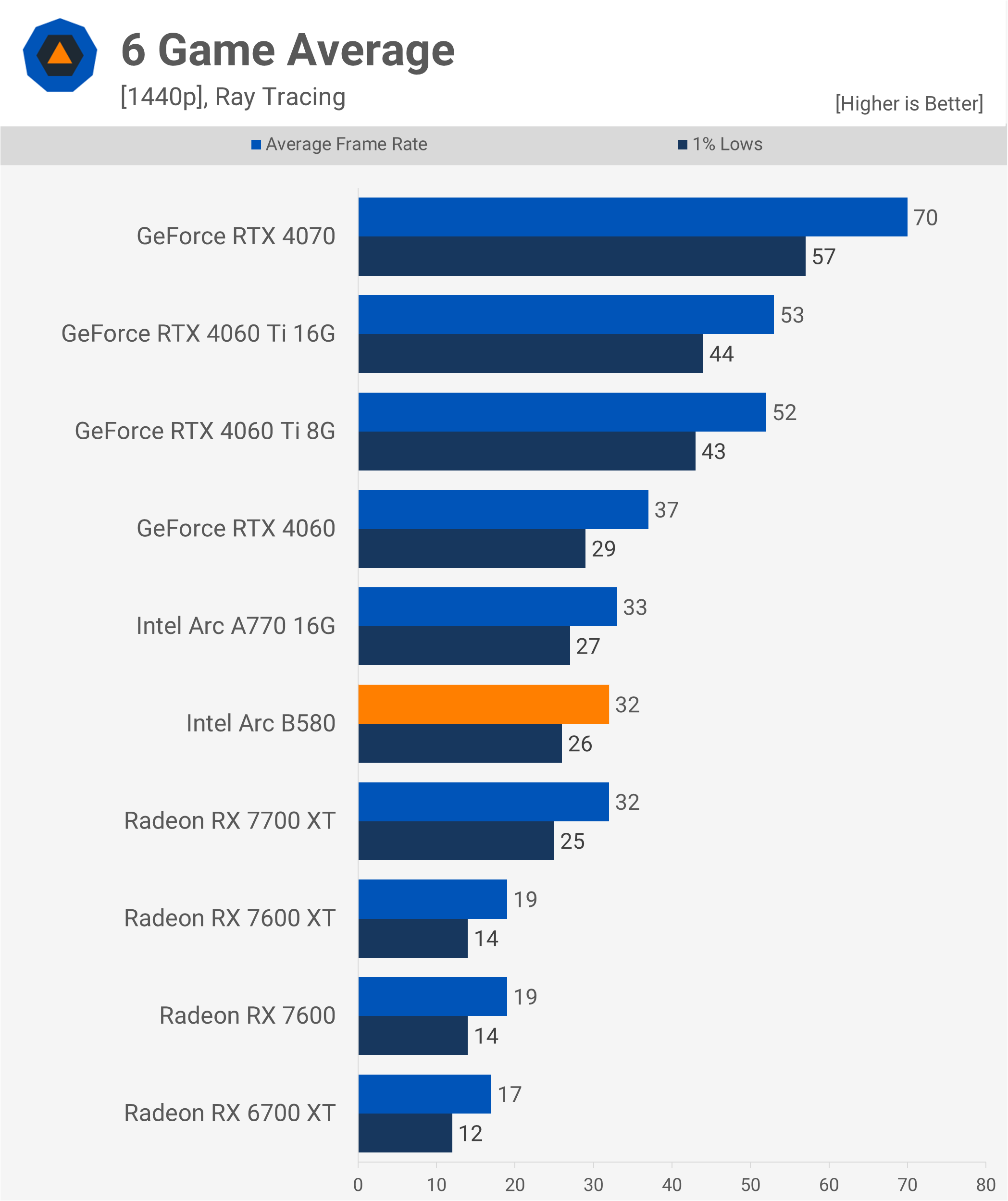
Cost per Frame – MSRP
Now it’s time to analyze the all-important cost per frame, and this is where the Arc B580 truly stands out, thanks to its $250 MSRP. Based on the 1440p data, the B580 delivers a 24% cost-per-frame advantage compared to the RX 7600 and a 27% advantage over the RTX 4060.

Before the B580’s release, we noted that if Intel could achieve a 20% cost-per-frame discount relative to the RTX 4060, it would be a success. Given that we’re seeing over a 20% discount here, the B580 appears to be well-positioned for success. However, let’s also examine real-world retail pricing.
Cost per Frame – Typical Retail Price
Even at current retail prices, the B580 remains a strong value. It offers a 21% lower cost per frame than the RX 7600, while maintaining the same 27% discount relative to the RTX 4060. For anyone purchasing an Arc B580 graphics card at launch, this represents an excellent deal.

Intel GPU Take Two: What We Learned
It’s fair to say that the Arc B580 is a great-value graphics card, at least in the current market. The cost-per-frame data clearly shows it offers at least 20% better value than competing products, and some of this analysis doesn’t even factor you’re getting 50% more VRAM.
Measuring the value of that additional VRAM can be difficult, as short benchmark runs often fail to reveal limitations when VRAM capacity is just at or slightly beyond its threshold. These benchmarks also don’t account for scenarios where games reduce texture quality automatically – cases in which performance can actually improve on models with insufficient VRAM.
Also see: How Much VRAM is Enough for PC Gaming?
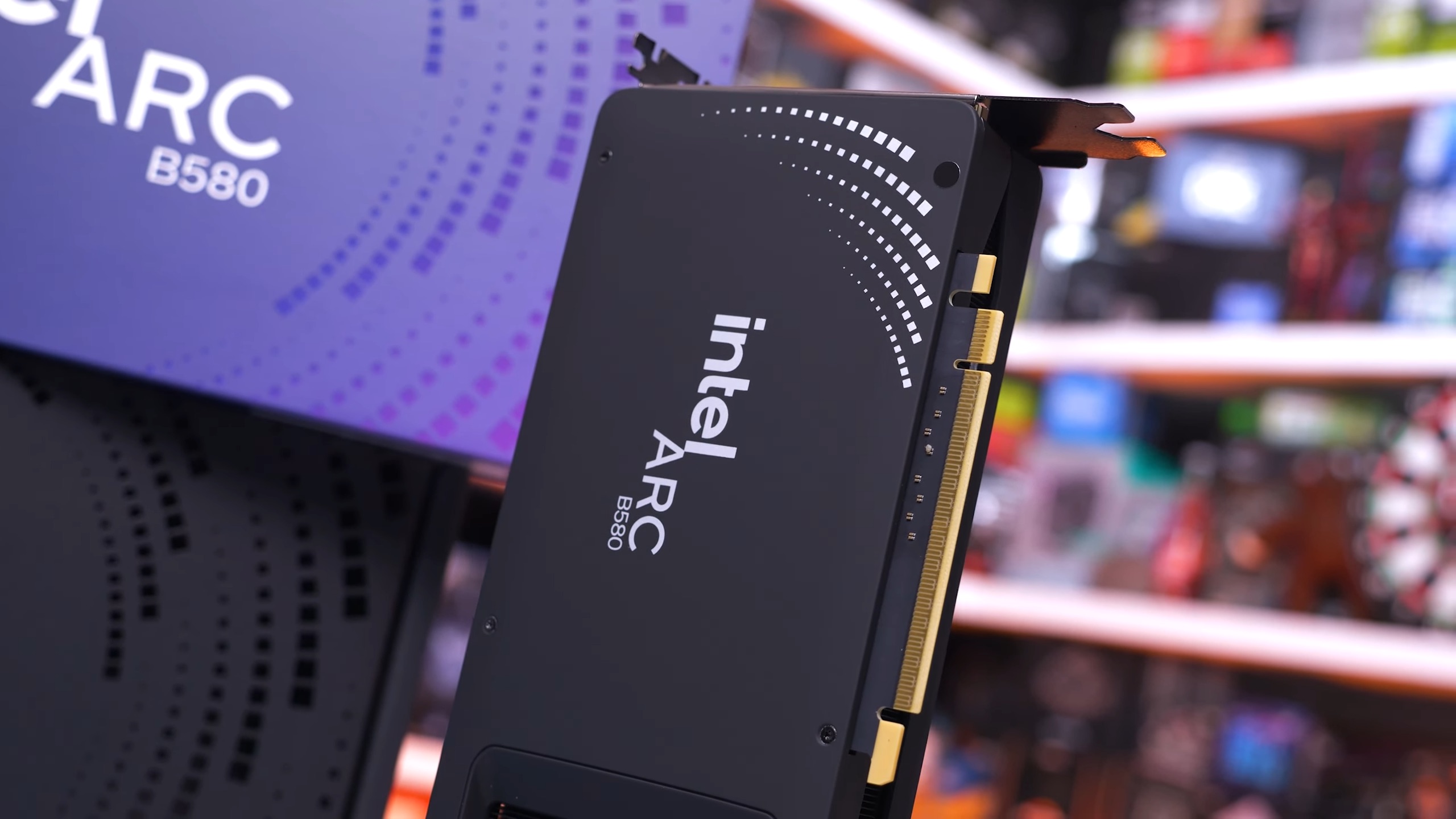
But what we can tell you that going from 8GB to 12GB of VRAM is invaluable. This will make the B580 a significantly more capable product than either the RX 7600 or RTX 4060 moving forward. Factoring this into the equation, the B580 stands out as an excellent value, outperforming anything AMD or Nvidia currently offer in this price range.
In terms of stability, the B580 performed well during testing – though not flawlessly. Nevertheless, it is sufficiently stable for its price point. Intel has made substantial improvements to stability and compatibility over the years, and even during the review process, most of the issues we encountered were resolved before the embargo lifted. That said, users are more likely to encounter occasional issues with the B580 compared to the Radeon 7600 or RTX 4060, which is why we feel the 20% discount is justified – and Intel has delivered on that promise.
Power consumption isn’t a major concern either. While using approximately 50 watts more than the RTX 4060 isn’t ideal, it’s far from a dealbreaker, especially given the significant price discount here.

Likewise, we aren’t overly concerned with ray tracing performance. Intel claims the B580 outperforms the RTX 4060 in ray tracing for titles that don’t heavily rely on RT effects, which is true for the majority of games. However, in titles where ray tracing is transformative to visuals, the RTX 4060 tends to perform better. But… given the lackluster ray tracing performance of GPUs under $600, ray tracing is not be a priority for this price segment.
As it stands, if you’re in the market for a graphics card under $300, your options are very limited. For a long time, the Radeon RX 6600 has been the go-to choice. However, with an average of just 34 fps at 1440p in our 12-game sample, the RX 6600 is almost 70% slower than the B580, making the B580’s roughly 30% higher price, along with 50% more VRAM, an easy investment to justify.
For gamers aiming for 1440p, the Radeon 6600 requires medium-to-low quality settings. With the arrival of the Intel Arc B580, AMD may need to price the RX 6600 at around $130. Similarly, the RX 7600 must drop to $200 to compete effectively, though even that won’t be very compelling given its 8GB VRAM. A more competitive price for the RX 7600 would be around $180, forcing AMD to slash prices by at least 30%.

The RTX 4060, currently priced at $300, would also need to fall to $200 at most – but that seems highly unlikely. As a result, the B580 has firmly established itself as the best option for entry-level gaming. It’s hard to recommend anything else. Intel has done an excellent job, achieving with their second generation what they couldn’t with their first.
On that note, it’s our opinion that Intel should fully commit to Arc desktop GPUs. While rumors have suggested that Intel will axe dGPUs after the Battlemage series, doing so would be a colossal mistake. The Arc lineup has been improving steadily, and though Intel still has much to do, giving up now would be disastrous.

Looking ahead, the Arc B570 is set to launch next month at $220, featuring a 10GB VRAM buffer. Even so, we expect the B580’s slight $30 premium to be well worth it, so it may not be worth waiting. The only concern we currently have is availability. Discussions with retailers suggest pre-sales for the B580 have been unexpectedly strong, with stock selling out rapidly. Even before reviews were live, enthusiasm for a $250 graphics card with 12GB of VRAM, which Intel claims outperforms the RTX 4060, was very high.
Given how impressive the Intel Arc B580 is, it’s likely that availability will suffer for at least the next few months. This is what you might call a high class problem for Intel, but it could be frustrating to buyers. Regardless, it’s exciting to finally have a sub-$300 graphics card worth recommending. We’re eager to see how Intel continues to develop the Arc GPU series.
Shopping Shortcuts:
- Intel Arc B580 on Amazon
- AMD Radeon RX 7600 on Amazon
- Nvidia GeForce RTX 4060 on Amazon
- Nvidia GeForce RTX 4070 Super on Amazon
- AMD Radeon RX 7800 XT on Amazon
- Nvidia GeForce RTX 4070 Ti Super on Amazon
- AMD Radeon RX 7900 XT on Amazon










